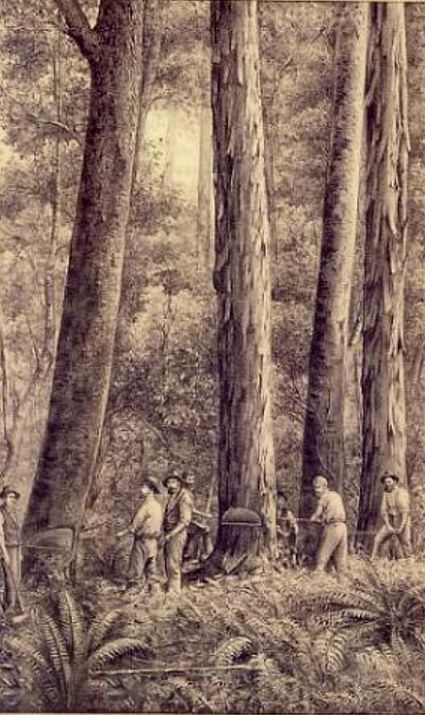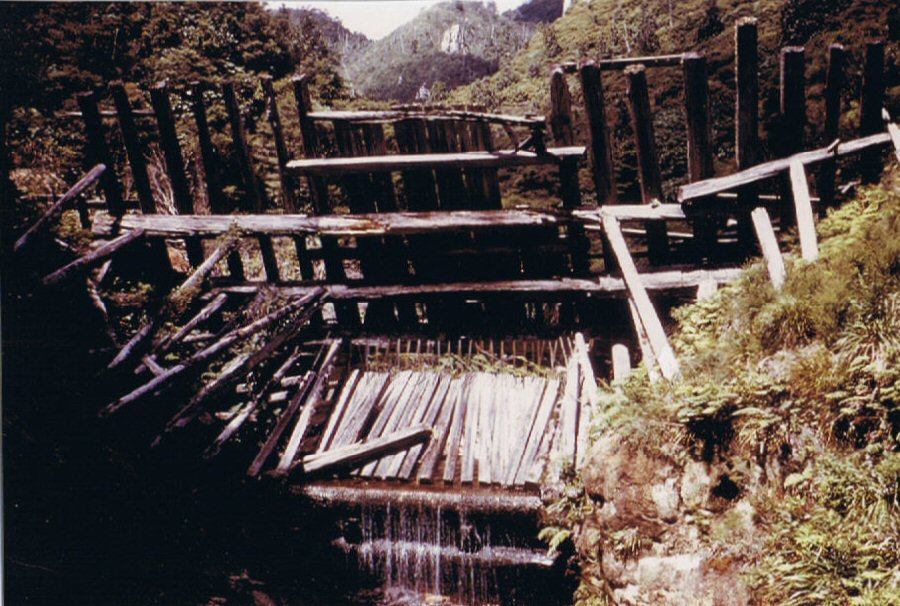|
Pittosporum Kirkii
''Pittosporum kirkii'' is a glabrous evergreen perennial shrub that reaches up to in height and possesses distinctive coriaceous, fleshy, thick leaves.Cooper RC 1956 The Australian and New Zealand species of ''Pittosporum''. ''Annals of the Missouri Botanical Garden'' 43: 87–188Myron KJ 2012 ''Pittosporum kirkii'': autecology of an endemic shrub epiphyte. Unpubl M.Sc Thesis. Hamilton, University of Waikato, url=http://researchcommons.waikato.ac.nz/handle/10289/6621 It is one of four shrubs endemic to New Zealand that frequently displays an epiphytic lifestyle. ''P. kirkii'' is commonly epiphytic, perched amongst nest epiphytes in the canopies of emergent or canopy trees in old-growth forest; however, it can be observed occasionally growing on the ground or over rocks (in a rupestral lifestyle). Kirk first observed ''P. kirkii'' on Great Barrier Island. It was described by Joseph Dalton Hooker from material collected by Thomas Kirk, possibly from the Thames Goldfields, and ... [...More Info...] [...Related Items...] OR: [Wikipedia] [Google] [Baidu] |
Joseph Dalton Hooker
Sir Joseph Dalton Hooker (30 June 1817 – 10 December 1911) was a British botanist and explorer in the 19th century. He was a founder of geographical botany and Charles Darwin's closest friend. For twenty years he served as director of the Royal Botanical Gardens, Kew, succeeding his father, William Jackson Hooker, and was awarded the highest honours of British science. Biography Early years Hooker was born in Halesworth, Suffolk, England. He was the second son of the famous botanist Sir William Jackson Hooker, Regius Professor of Botany, and Maria Sarah Turner, eldest daughter of the banker Dawson Turner and sister-in-law of Francis Palgrave. From age seven, Hooker attended his father's lectures at Glasgow University, taking an early interest in plant distribution and the voyages of explorers like Captain James Cook. He was educated at the Glasgow High School and went on to study medicine at Glasgow University, graduating M.D. in 1839. This degree qualified him for ... [...More Info...] [...Related Items...] OR: [Wikipedia] [Google] [Baidu] |
Thomas Kirk (botanist)
Thomas Kirk (18 January 1828 – 8 March 1898) was an English-born botanist, teacher, public servant, writer and churchman who moved to New Zealand with his wife and four children in late 1862. The New Zealand government commissioned him in 1884 to compile a report on the indigenous forests of the country and appointed him as chief conservator of forests the following year. He published 130 papers in botany and plants including ''The Durability of New Zealand Timbers'', ''The Forest Flora of New Zealand'' and ''Students' Flora of New Zealand''. Early life and career Thomas was the son of a Coventry nurseryman, George Kirk, and Sarah West, a florist. As a consequence of his parents' involvement in nursery work, he displayed a keen interest in botany, and later worked at a timber mill in Coventry. On Christmas Day 1850 he married a silk marker, Sarah Jane Mattocks. Poor health and financial problems led to his emigrating to Auckland, arriving with his family on 9 February 1863. Th ... [...More Info...] [...Related Items...] OR: [Wikipedia] [Google] [Baidu] |
Glabrousness (botany)
Glabrousness (from the Latin ''glaber'' meaning "bald", "hairless", "shaved", "smooth") is the technical term for a lack of hair, down, setae, trichomes or other such covering. A glabrous surface may be a natural characteristic of all or part of a plant or animal, or be due to loss because of a physical condition, such as alopecia universalis in humans, which causes hair to fall out or not regrow. In botany Glabrousness or otherwise, of leaves, stems, and fruit is a feature commonly mentioned in plant keys; in botany and mycology, a ''glabrous'' morphological feature is one that is smooth and may be glossy. It has no bristles or hair-like structures such as trichomes. In anything like the zoological sense, no plants or fungi have hair or wool, although some structures may resemble such materials. The term "glabrous" strictly applies only to features that lack trichomes at all times. When an organ bears trichomes at first, but loses them with age, the term used is ''glabrescen ... [...More Info...] [...Related Items...] OR: [Wikipedia] [Google] [Baidu] |
Coriaceous
This glossary of botanical terms is a list of definitions of terms and concepts relevant to botany and plants in general. Terms of plant morphology are included here as well as at the more specific Glossary of plant morphology and Glossary of leaf morphology. For other related terms, see Glossary of phytopathology, Glossary of lichen terms, and List of Latin and Greek words commonly used in systematic names. A B ... [...More Info...] [...Related Items...] OR: [Wikipedia] [Google] [Baidu] |
New Zealand
New Zealand ( mi, Aotearoa ) is an island country in the southwestern Pacific Ocean. It consists of two main landmasses—the North Island () and the South Island ()—and over 700 smaller islands. It is the sixth-largest island country by area, covering . New Zealand is about east of Australia across the Tasman Sea and south of the islands of New Caledonia, Fiji, and Tonga. The country's varied topography and sharp mountain peaks, including the Southern Alps, owe much to tectonic uplift and volcanic eruptions. New Zealand's capital city is Wellington, and its most populous city is Auckland. The islands of New Zealand were the last large habitable land to be settled by humans. Between about 1280 and 1350, Polynesians began to settle in the islands and then developed a distinctive Māori culture. In 1642, the Dutch explorer Abel Tasman became the first European to sight and record New Zealand. In 1840, representatives of the United Kingdom and Māori chiefs ... [...More Info...] [...Related Items...] OR: [Wikipedia] [Google] [Baidu] |
Epiphytic
An epiphyte is an organism that grows on the surface of a plant and derives its moisture and nutrients from the air, rain, water (in marine environments) or from debris accumulating around it. The plants on which epiphytes grow are called phorophytes. Epiphytes take part in nutrient cycles and add to both the diversity and biomass of the ecosystem in which they occur, like any other organism. They are an important source of food for many species. Typically, the older parts of a plant will have more epiphytes growing on them. Epiphytes differ from parasites in that they grow on other plants for physical support and do not necessarily affect the host negatively. An organism that grows on another organism that is not a plant may be called an epibiont. Epiphytes are usually found in the temperate zone (e.g., many mosses, liverworts, lichens, and algae) or in the tropics (e.g., many ferns, cacti, orchids, and bromeliads). Epiphyte species make good houseplants due to their minimal water ... [...More Info...] [...Related Items...] OR: [Wikipedia] [Google] [Baidu] |
Canopy (biology)
In biology, the canopy is the aboveground portion of a plant cropping or crop, formed by the collection of individual plant crowns. In forest ecology, canopy also refers to the upper layer or habitat zone, formed by mature tree crowns and including other biological organisms ( epiphytes, lianas, arboreal animals, etc.). The communities that inhabit the canopy layer are thought to be involved in maintaining forest diversity, resilience, and functioning. Sometimes the term canopy is used to refer to the extent of the outer layer of leaves of an individual tree or group of trees. Shade trees normally have a dense canopy that blocks light from lower growing plants. Observation Early observations of canopies were made from the ground using binoculars or by examining fallen material. Researchers would sometimes erroneously rely on extrapolation by using more reachable samples taken from the understory. In some cases, they would use unconventional methods such as chairs susp ... [...More Info...] [...Related Items...] OR: [Wikipedia] [Google] [Baidu] |
Old-growth Forest
An old-growth forestalso termed primary forest, virgin forest, late seral forest, primeval forest, or first-growth forestis a forest that has attained great age without significant disturbance, and thereby exhibits unique ecological features, and might be classified as a climax community. The Food and Agriculture Organization of the United Nations defines primary forests as naturally regenerated forests of native tree species where there are no clearly visible indications of human activity and the ecological processes are not significantly disturbed. More than one-third (34 percent) of the world's forests are primary forests. Old-growth features include diverse tree-related structures that provide diverse wildlife habitat that increases the biodiversity of the forested ecosystem. Virgin or first-growth forests are old-growth forests that have never been logged. The concept of diverse tree structure includes multi-layered canopies and canopy gaps, greatly varying tree height ... [...More Info...] [...Related Items...] OR: [Wikipedia] [Google] [Baidu] |
Great Barrier Island
Great Barrier Island ( mi, Aotea) lies in the outer Hauraki Gulf, New Zealand, north-east of central Auckland. With an area of it is the sixth-largest island of New Zealand and fourth-largest in the main chain. Its highest point, Mount Hobson, is above sea level.Great Barrier Island Aotea page on the DOC website (from the . Accessed 2008-06-04.) The is the [...More Info...] [...Related Items...] OR: [Wikipedia] [Google] [Baidu] |
Thomas Frederic Cheeseman
Thomas Frederick Cheeseman (8 June 184515 October 1923) was a New Zealand botanist. He was also a naturalist who had wide-ranging interests, such that he even described a few species of sea slugs (marine gastropod molluscs). Biography Cheeseman was born at Hull, in Yorkshire on 8 June 1845, the eldest of five children. He came to New Zealand at the age of eight with his parents on the ''Artemesia'', arriving in Auckland on 4 April 1854. He was educated at Parnell Grammar School and then at St John's College, Auckland. His father, the Rev. Thomas Cheeseman, had been a member of the old Auckland Provincial Council. Cheeseman started studying the flora of New Zealand, and in 1872 he published an accurate and comprehensive account of the plant life of the Waitākere Ranges. In 1874, he was appointed Secretary of the Auckland Institute and Curator of the Auckland Museum, which had only recently been founded. For the first three decades, Cheeseman was the only staff member who w ... [...More Info...] [...Related Items...] OR: [Wikipedia] [Google] [Baidu] |
Plant Sexuality
Plant reproductive morphology is the study of the physical form and structure (the Plant morphology, morphology) of those parts of plants directly or indirectly concerned with sexual reproduction. Among all living organisms, flowers, which are the reproductive structures of flowering plant, angiosperms, are the most varied physically and show a correspondingly great diversity in methods of reproduction. Plants that are not flowering plants (green algae, mosses, Marchantiophyta, liverworts, hornworts, ferns and gymnosperms such as conifers) also have complex interplays between morphological adaptation and environmental factors in their sexual reproduction. The breeding system, or how the sperm from one plant fertilizes the ovum of another, depends on the reproductive morphology, and is the single most important determinant of the genetic structure of nonclonal plant populations. Christian Konrad Sprengel (1793) studied the reproduction of flowering plants and for the first time it ... [...More Info...] [...Related Items...] OR: [Wikipedia] [Google] [Baidu] |








